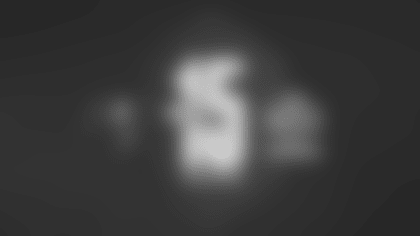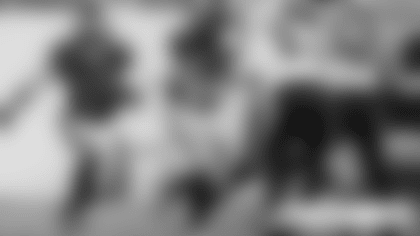Did Maurice Stovall get his feet inbounds before the defender shoved him out? It will matter more next season
The field just got a little smaller for wide receivers.
The NFL tweaks its rulebook every offseason, mainly in the name of competition and fairness. Earlier this week, for example, a vote at the owner's meeting passed, after three years of trying, a proposal that will give one defensive player on the field the same helmet-radio convenience quarterbacks have enjoyed since 1994.
One day later, another rule passed that takes a little bit of real estate away from the league's receivers.
The field is still 120 yards long (with end zones) and 53.3 yards wide, of course. No one is looking to mess with the game's age-old dimensions. But, after the NFL passed a proposal this week to change the "forceout rule" along the sidelines, receivers might feel as if the edges are squeezing in on them.
In previous seasons, if a receiver (or a defender making an interception) caught a pass near the sideline with one or both feet off the ground, and was pushed out of bounds by a defender before he could get both feet down, the play was often ruled a catch. If the officials determined that the receiver would have gotten both feet down without being hit – and if the receiver maintains possession through any subsequent contact with the ground – the reception was good, whether he got two, one or zero feet down inbounds.
Now that rule has been eliminated. Plain and simple, a receiver must get both feet down inbounds to get credit for a catch. If a defender's hit keeps the receiver from doing so, well, that's just good defense.
"It's instinct to hit that guy – we were going to do it anyway," said Tampa Bay Buccaneers safety Tanard Jackson. "To me, that rule didn't really make sense, because it negated the other rule of the receiver having to have both feet inbounds. I'm glad they changed that."
Surprisingly, the elimination of the forceout rule received much less attention than the helmet-radio news. In terms of the various proposals being bounced around at the owners' meetings in Palm Beach, it was even overshadowed by a proposal to force players to keep their hair from covering their nameplates (that one was eventually tabled, for now).
In fact, as of the end of the players' work week at One Buccaneer Place, where the team is in the middle of its 14-week offseason training program, news of the forceout rule elimination hadn't even hit the Bucs' locker room. Jackson reacted with surprise, and then an honest response: "That's good news!"
The helmet-radio resolution produced mixed responses from the Buccaneers, but the split was between players and management. General Manager Bruce Allen and Head Coach Jon Gruden did not believe the defensive helmet radio was necessary, and the Bucs were one of seven teams to vote against it. In the locker room, however, the defenders considered it good news and even quarterback Jeff Garcia conceded that it was a fair decision.
The elimination of the forceout rule, however, is sure to create two camps in the locker room, split down an obvious line. Don't expect pass-catchers to be happy about yet another demand on their athleticism.
"I don't really see the point in changing that rule," said wide receiver Maurice Stovall. "Obviously, it makes things a little harder on the receiver and easier on the defense. It's the NFL and it's tough already to get open, so that rule will just make it a little harder. But if you get separation you don't even have to worry about that."
The rule change could come in to play anywhere along the fields 920 linear feet of sideline, but its impact may be felt most in the end zones. Open spaces are hard to come by when a team is trying to throw into the end from inside the 10-yard line, and many routes specifically take players to the back or sides of the end zone. The "fade pass" for instance, is a common call inside the five-yard line, and it usually ends up as a one-on-one battle for a lob pass between the receiver and the defensive back. The well-timed shove will now be another weapon in the defender's arsenal.
The elimination of the rule also closes a frustrating hole in the instant replay system. The forceout rule was not a reviewable situation, so there was no way for the defense to challenge if it appeared as if the contact was not what caused the receiver to land out of bounds. (Whether or not he maintained possession upon hitting the ground was still reviewable.) Now, it's cut-and-dried: Did the receiver get two feet inbounds? If the defense feels otherwise, it will be able to challenge.
To a defender like Jackson, it's a common-sense change – knocking a player out of bounds is just another way of denying a catch. To a receiver like Stovall, it's a matter of fixing something that wasn't broken – why change a long-standing rule only to make things harder on the offense.
Everyone agrees, however, which side will benefit from the change.
"It definitely works out to the advantage of the defense, the defensive backs especially," said Jackson. "You find yourself in that situation a lot, where the receiver is on the edge and both of his feet are off the ground. If you force him out, they usually ruled that a catch. Now, I guess it's not. So it definitely works to our advantage."






















